coolant reservoir HYUNDAI I40 2016 Owners Manual
[x] Cancel search | Manufacturer: HYUNDAI, Model Year: 2016, Model line: I40, Model: HYUNDAI I40 2016Pages: 534, PDF Size: 11.05 MB
Page 22 of 534
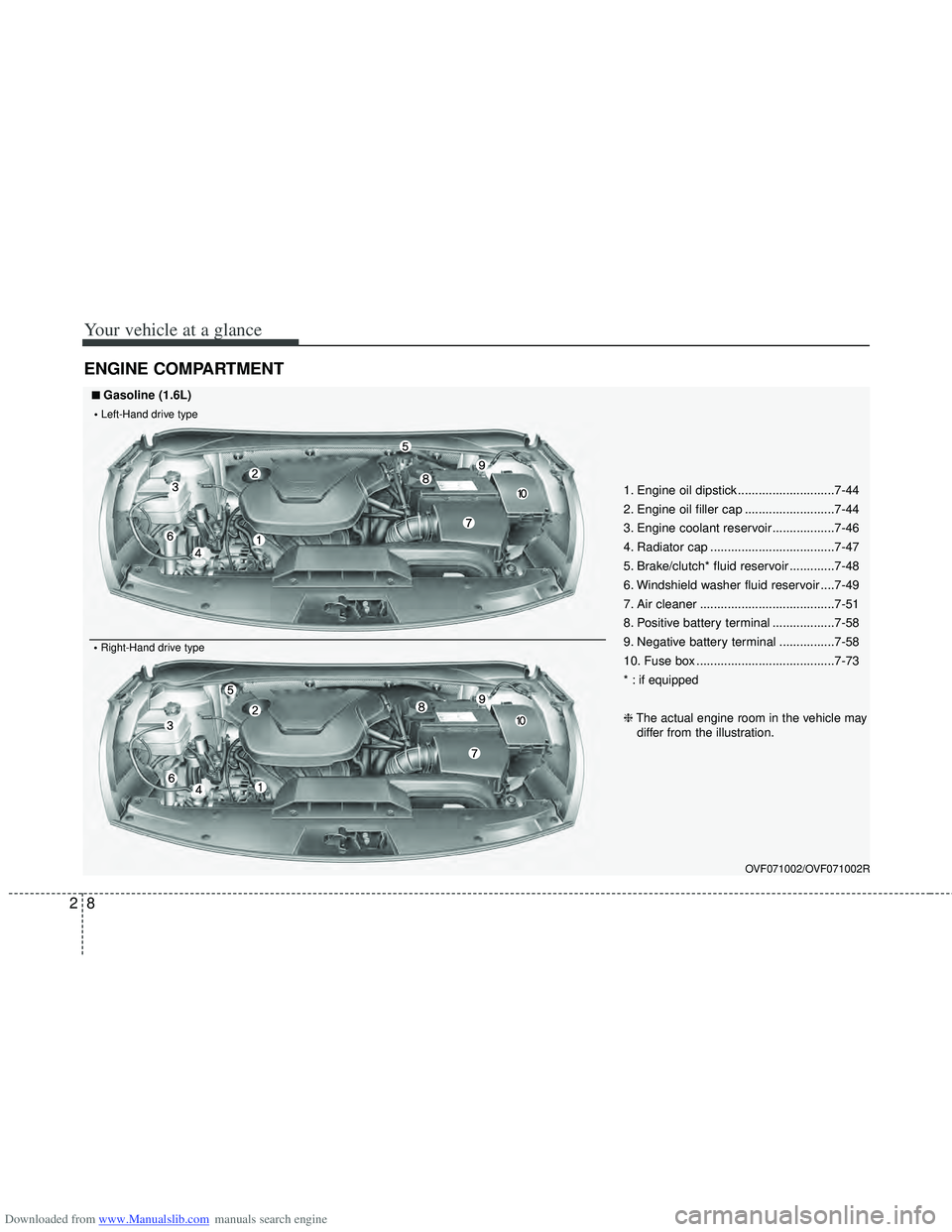
Downloaded from www.Manualslib.com manuals search engine Your vehicle at a glance
82
ENGINE COMPARTMENT
OVF071002/OVF071002R
1. Engine oil dipstick ............................7-44
2. Engine oil filler cap ..........................7-44
3. Engine coolant reservoir ..................7-46
4. Radiator cap ....................................7-47
5. Brake/clutch* fluid reservoir .............7-48
6. Windshield washer fluid reservoir ....7-49
7. Air cleaner .......................................7-51
8. Positive battery terminal ..................7-58
9. Negative battery terminal ................7-58
10. Fuse box ........................................7-73
* : if equipped
❈The actual engine room in the vehicle may
differ from the illustration.
■
■Gasoline (1.6L)
• Right-Hand drive type
Left-Hand drive type
Page 23 of 534
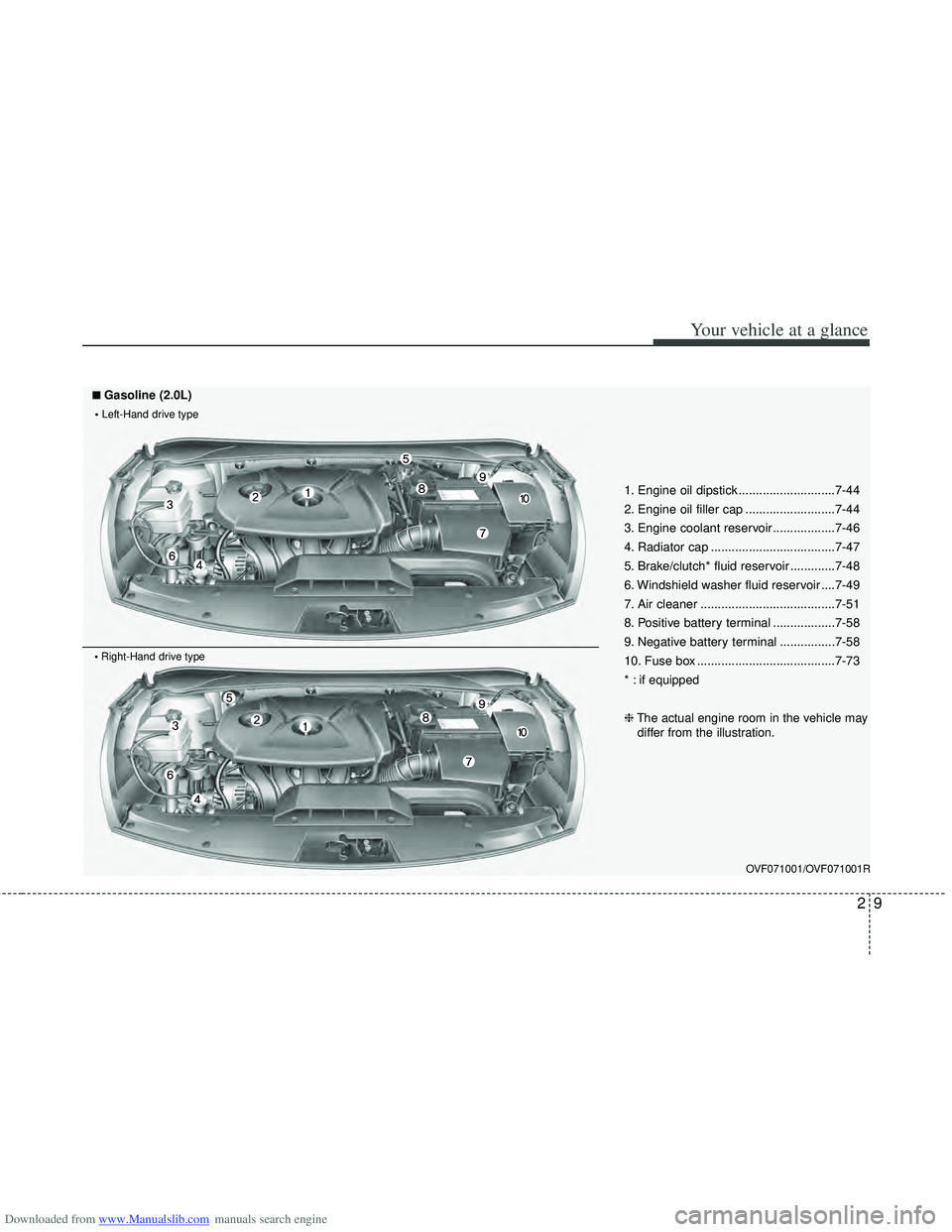
Downloaded from www.Manualslib.com manuals search engine 29
Your vehicle at a glance
OVF071001/OVF071001R
1. Engine oil dipstick ............................7-44
2. Engine oil filler cap ..........................7-44
3. Engine coolant reservoir ..................7-46
4. Radiator cap ....................................7-47
5. Brake/clutch* fluid reservoir .............7-48
6. Windshield washer fluid reservoir ....7-49
7. Air cleaner .......................................7-51
8. Positive battery terminal ..................7-58
9. Negative battery terminal ................7-58
10. Fuse box ........................................7-73
* : if equipped
❈The actual engine room in the vehicle may
differ from the illustration.
■
■Gasoline (2.0L)
Right-Hand drive type
Left-Hand drive type
Page 24 of 534
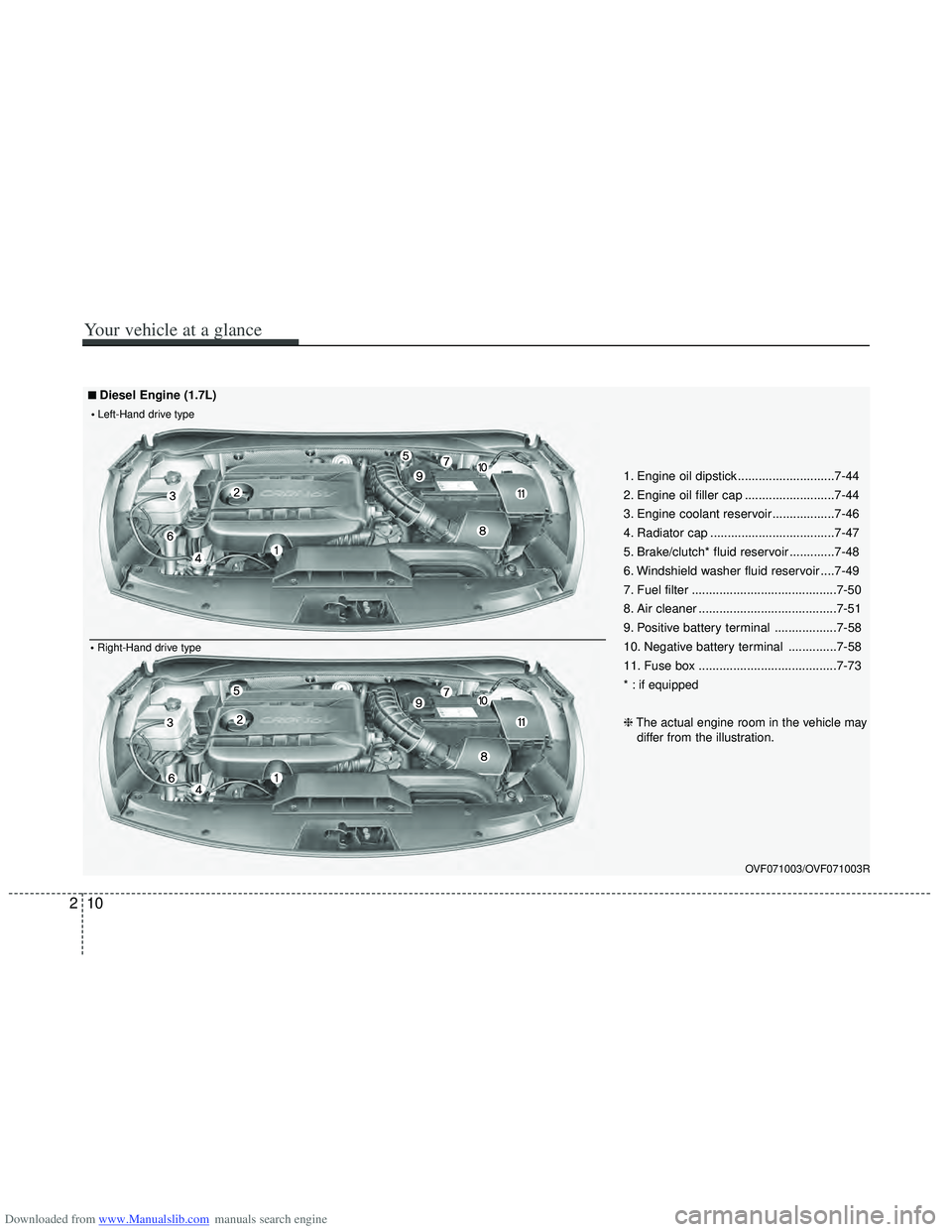
Downloaded from www.Manualslib.com manuals search engine 210
Your vehicle at a glance
OVF071003/OVF071003R
1. Engine oil dipstick ............................7-44
2. Engine oil filler cap ..........................7-44
3. Engine coolant reservoir ..................7-46
4. Radiator cap ....................................7-47
5. Brake/clutch* fluid reservoir .............7-48
6. Windshield washer fluid reservoir ....7-49
7. Fuel filter ..........................................7-50
8. Air cleaner ........................................7-51
9. Positive battery terminal ..................7-58
10. Negative battery terminal ..............7-58
11. Fuse box ........................................7-73
* : if equipped
❈The actual engine room in the vehicle may
differ from the illustration.
■
■Diesel Engine (1.7L)
Right-Hand drive type
Left-Hand drive type
Page 137 of 534
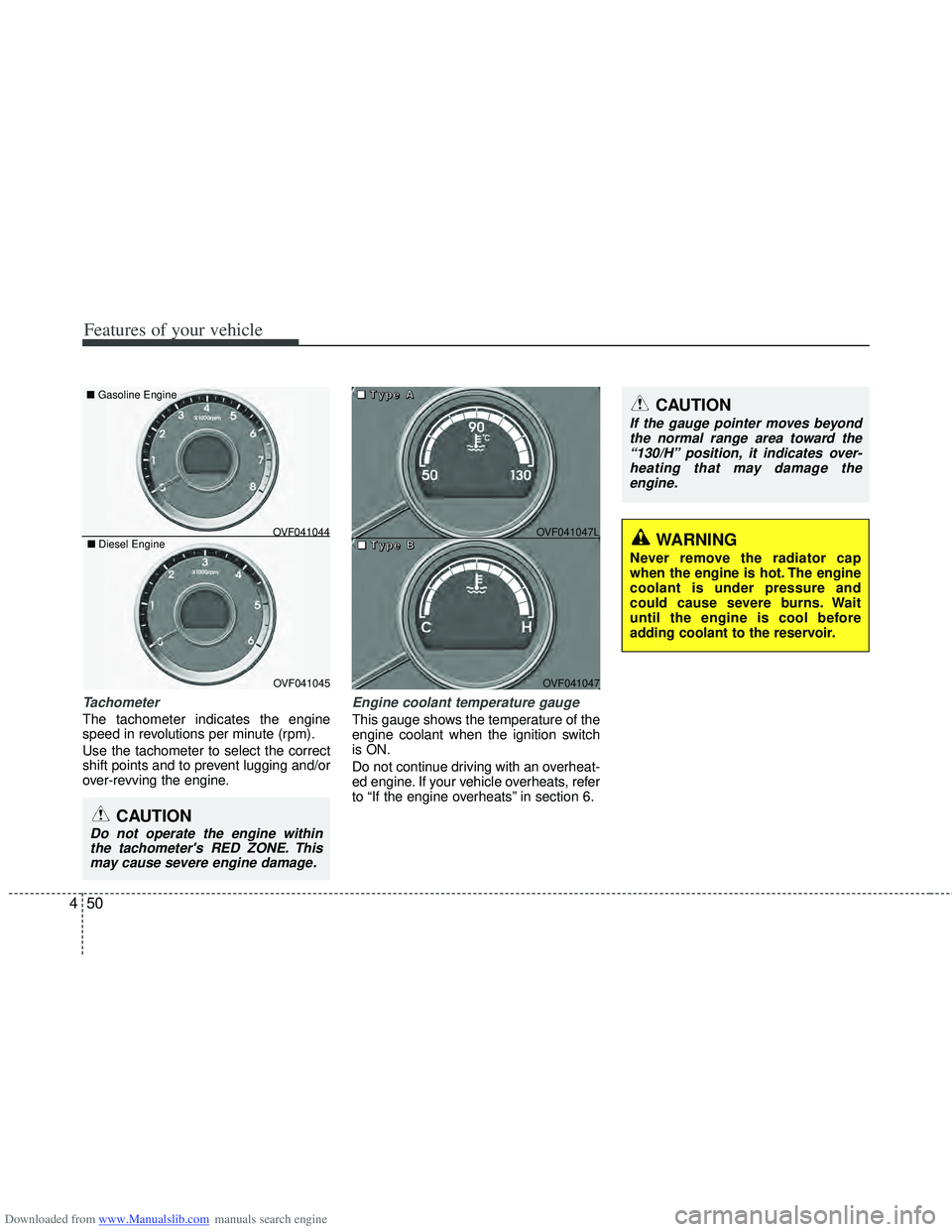
Downloaded from www.Manualslib.com manuals search engine Features of your vehicle
50
4
Tachometer
The tachometer indicates the engine
speed in revolutions per minute (rpm).
Use the tachometer to select the correct
shift points and to prevent lugging and/or
over-revving the engine.
Engine coolant temperature gauge
This gauge shows the temperature of the
engine coolant when the ignition switch
is ON.
Do not continue driving with an overheat-
ed engine. If your vehicle overheats, refer
to “If the engine overheats” in section 6.
CAUTION
Do not operate the engine within
the tachometer's RED ZONE. Thismay cause severe engine damage.
■ Gasoline Engine
■ Diesel Engine
OVF041045
OVF041044
■
■
■
■
T
T
T
T
y
y
y
y
p
p
p
p
e
e
e
e
A
A
A
A
■
■
■
■
T
T
T
T
y
y
y
y
p
p
p
p
e
e
e
e
B
B
B
B
OVF041047
OVF041047L
CAUTION
If the gauge pointer moves beyondthe normal range area toward the“130/H” position, it indicates over- heating that may damage theengine.
WARNING
Never remove the radiator cap
when the engine is hot. The engine
coolant is under pressure and
could cause severe burns. Wait
until the engine is cool before
adding coolant to the reservoir.
Page 382 of 534
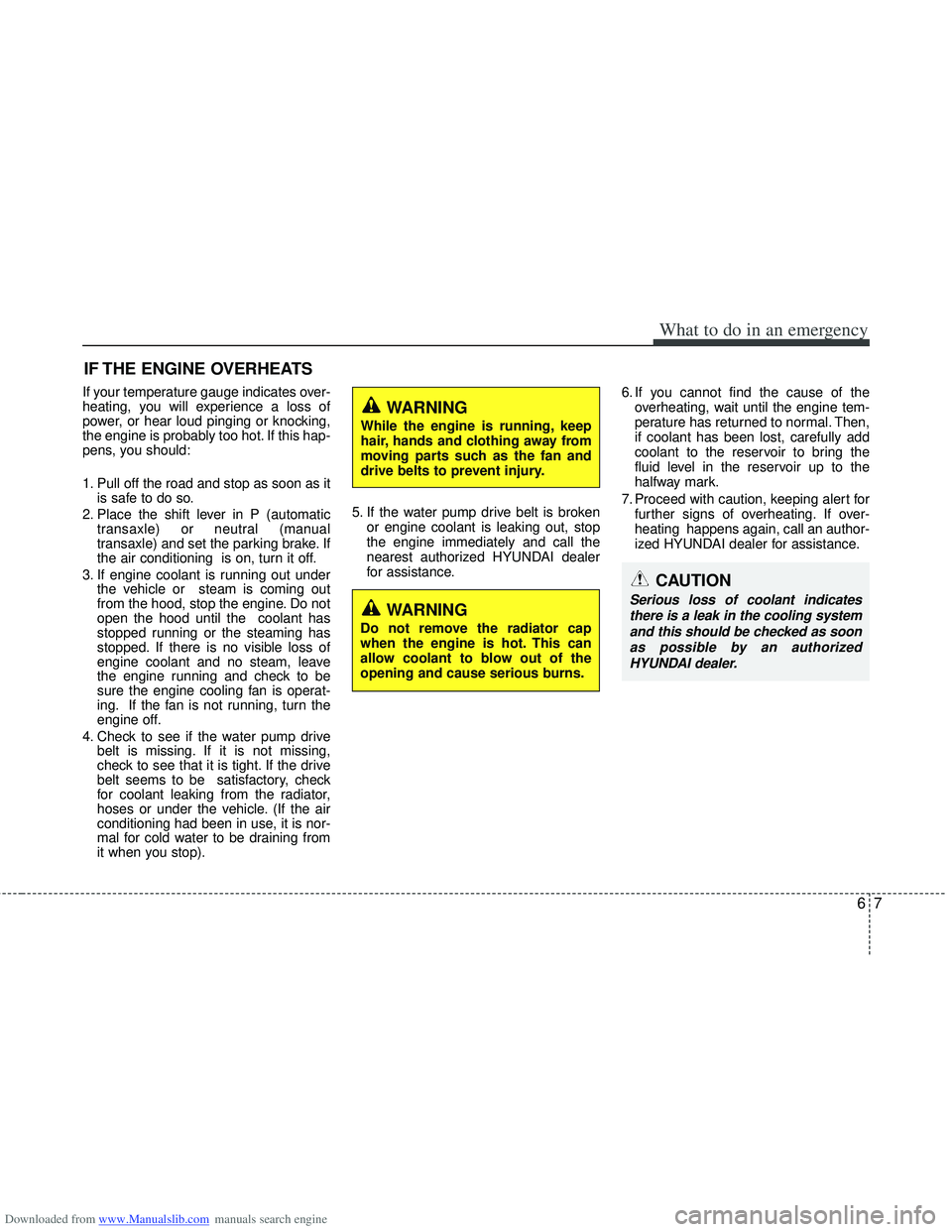
Downloaded from www.Manualslib.com manuals search engine 67
What to do in an emergency
IF THE ENGINE OVERHEATS
If your temperature gauge indicates over-
heating, you will experience a loss of
power, or hear loud pinging or knocking,
the engine is probably too hot. If this hap-
pens, you should:
1. Pull off the road and stop as soon as itis safe to do so.
2. Place the shift lever in P (automatic transaxle) or neutral (manual
transaxle) and set the parking brake. If
the air conditioning is on, turn it off.
3. If engine coolant is running out under the vehicle or steam is coming out
from the hood, stop the engine. Do not
open the hood until the coolant has
stopped running or the steaming has
stopped. If there is no visible loss of
engine coolant and no steam, leave
the engine running and check to be
sure the engine cooling fan is operat-
ing. If the fan is not running, turn the
engine off.
4. Check to see if the water pump drive belt is missing. If it is not missing,
check to see that it is tight. If the drive
belt seems to be satisfactory, check
for coolant leaking from the radiator,
hoses or under the vehicle. (If the air
conditioning had been in use, it is nor-
mal for cold water to be draining from
it when you stop). 5. If the water pump drive belt is broken
or engine coolant is leaking out, stop
the engine immediately and call the
nearest authorized HYUNDAI dealer
for assistance. 6. If you cannot find the cause of the
overheating, wait until the engine tem-
perature has returned to normal. Then,
if coolant has been lost, carefully add
coolant to the reservoir to bring the
fluid level in the reservoir up to the
halfway mark.
7. Proceed with caution, keeping alert for further signs of overheating. If over-
heating happens again, call an author-
ized HYUNDAI dealer for assistance.
CAUTION
Serious loss of coolant indicates
there is a leak in the cooling systemand this should be checked as soonas possible by an authorizedHYUNDAI dealer.
WARNING
While the engine is running, keep
hair, hands and clothing away from
moving parts such as the fan and
drive belts to prevent injury.
WARNING
Do not remove the radiator cap
when the engine is hot. This can
allow coolant to blow out of the
opening and cause serious burns.
Page 407 of 534
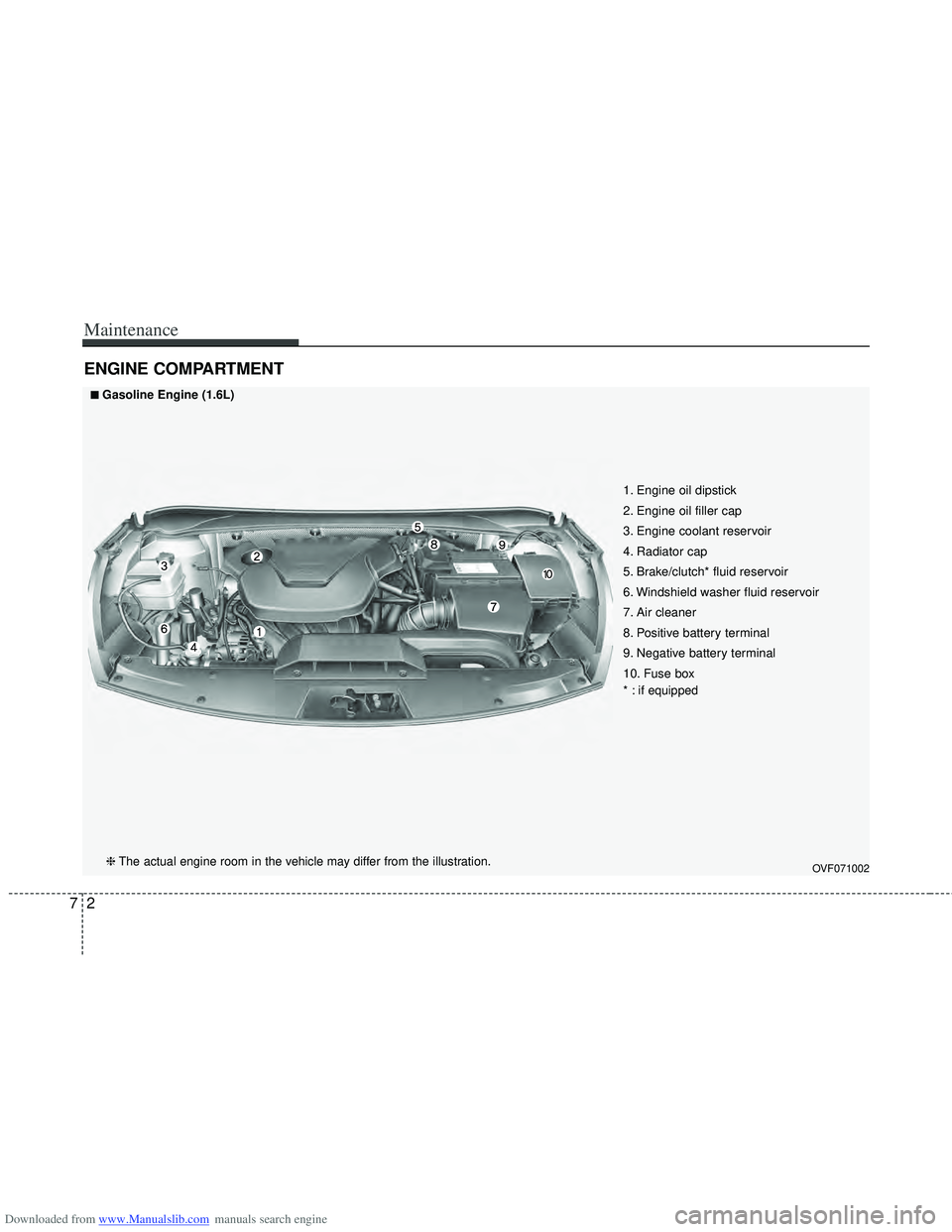
Downloaded from www.Manualslib.com manuals search engine Maintenance
27
ENGINE COMPARTMENT
OVF071002
1. Engine oil dipstick
2. Engine oil filler cap
3. Engine coolant reservoir
4. Radiator cap
5. Brake/clutch* fluid reservoir
6. Windshield washer fluid reservoir
7. Air cleaner
8. Positive battery terminal
9. Negative battery terminal
10. Fuse box
* : if equipped
■ ■Gasoline Engine (1.6L)❈ The actual engine room in the vehicle may differ from the illustration.
Page 408 of 534
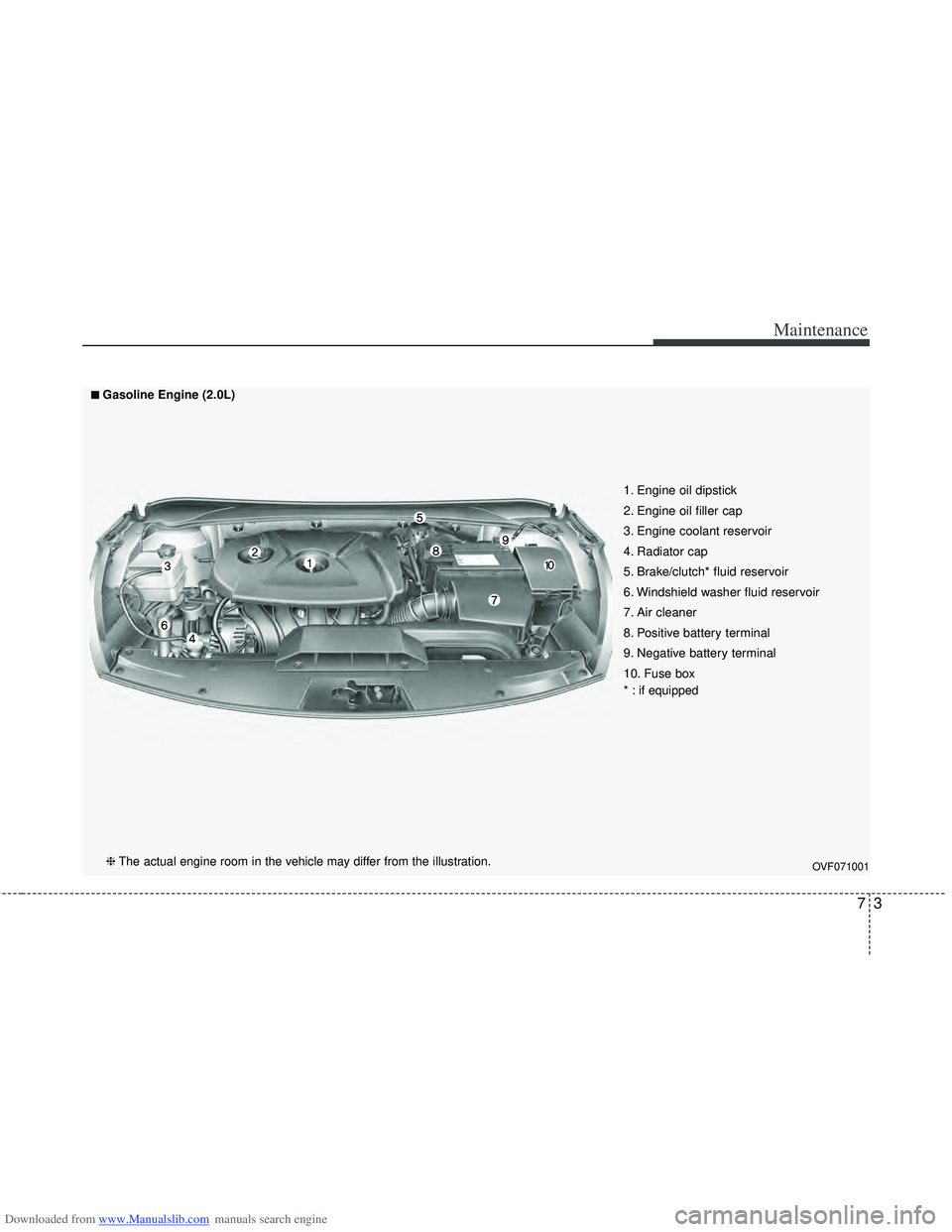
Downloaded from www.Manualslib.com manuals search engine 73
Maintenance
OVF071001
1. Engine oil dipstick
2. Engine oil filler cap
3. Engine coolant reservoir
4. Radiator cap
5. Brake/clutch* fluid reservoir
6. Windshield washer fluid reservoir
7. Air cleaner
8. Positive battery terminal
9. Negative battery terminal
10. Fuse box
* : if equipped
■
■Gasoline Engine (2.0L)
❈The actual engine room in the vehicle may differ from the illustration.
Page 409 of 534
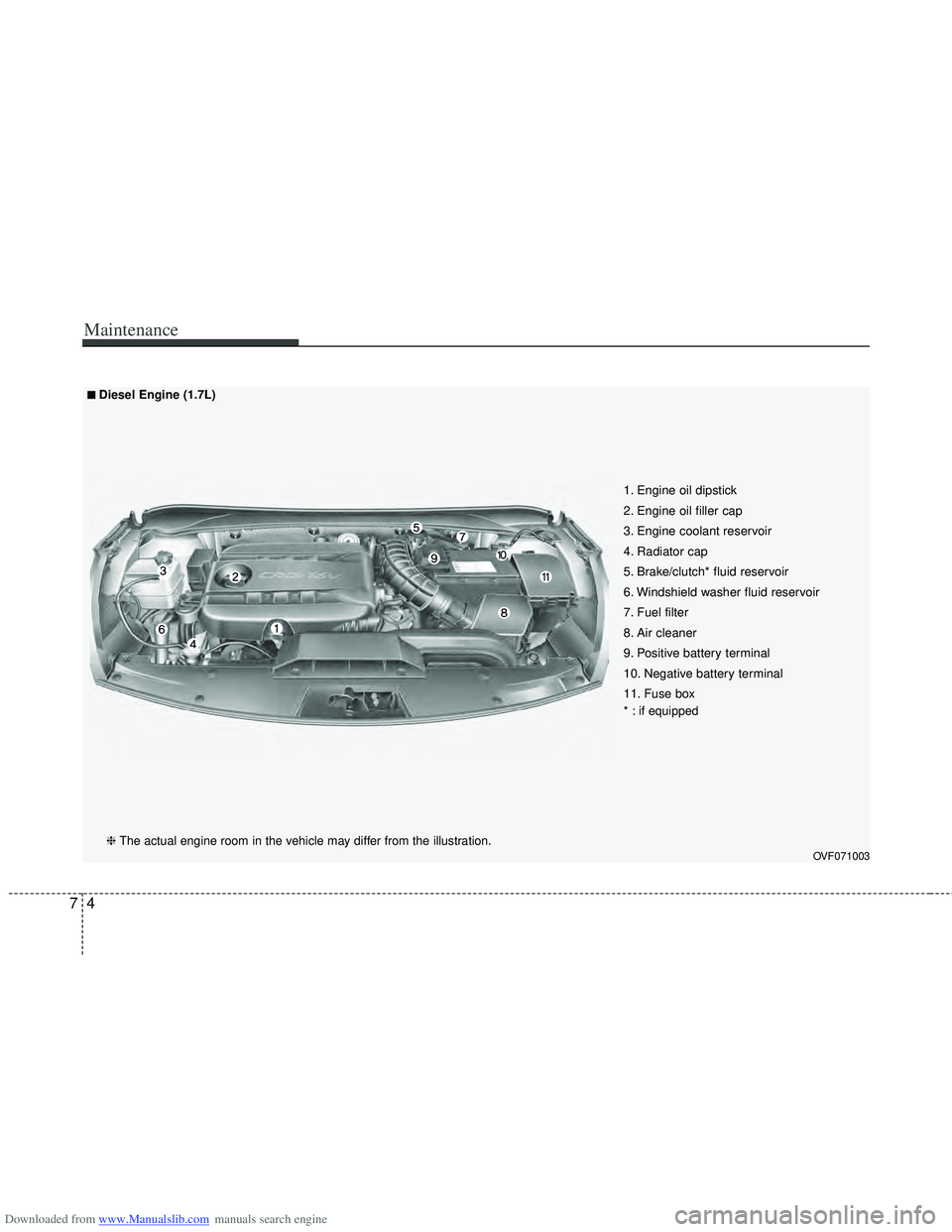
Downloaded from www.Manualslib.com manuals search engine Maintenance
47
OVF071003
1. Engine oil dipstick
2. Engine oil filler cap
3. Engine coolant reservoir
4. Radiator cap
5. Brake/clutch* fluid reservoir
6. Windshield washer fluid reservoir
7. Fuel filter
8. Air cleaner
9. Positive battery terminal
10. Negative battery terminal
11. Fuse box
* : if equipped
■
■Diesel Engine (1.7L)❈ The actual engine room in the vehicle may differ from the illustration.
Page 413 of 534
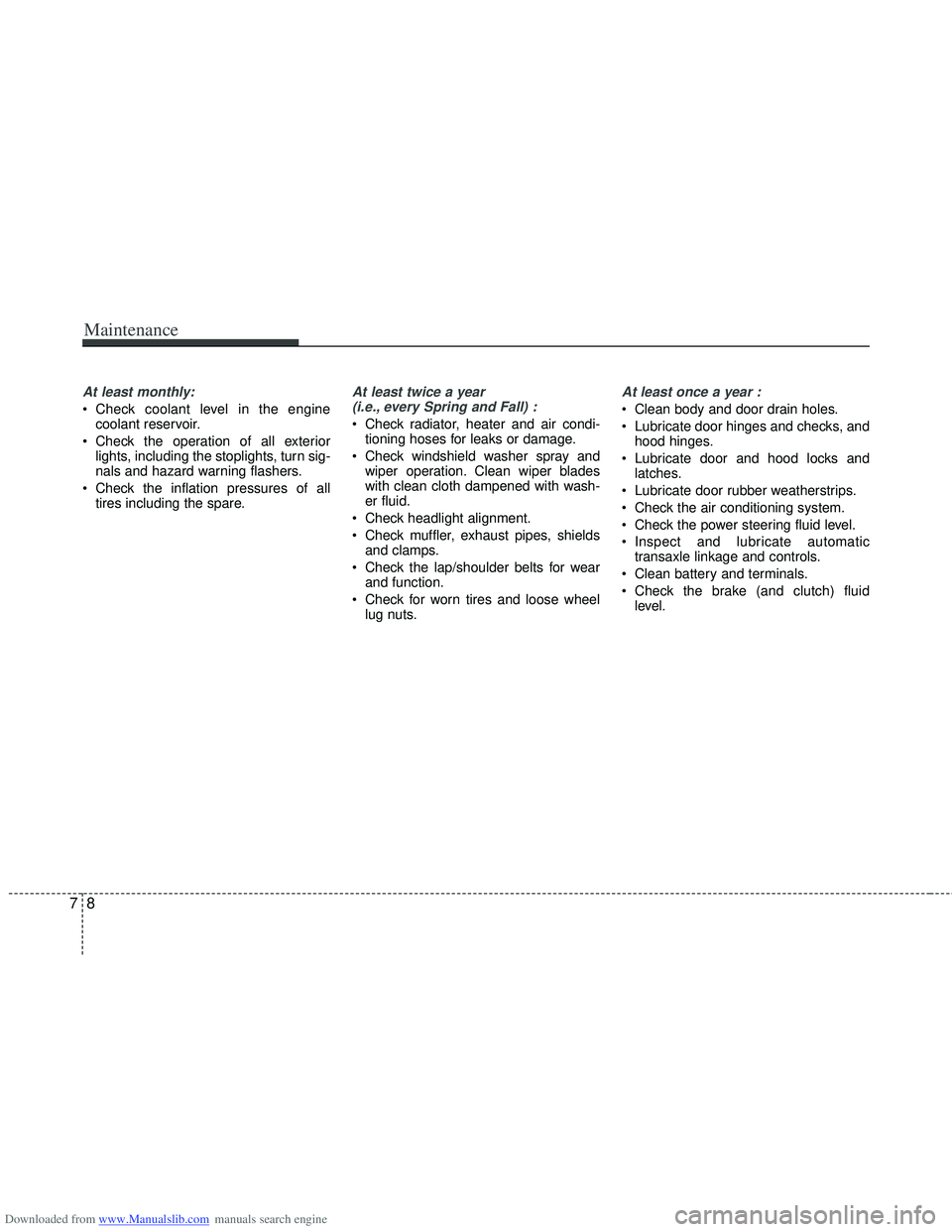
Downloaded from www.Manualslib.com manuals search engine Maintenance
87
At least monthly:
Check coolant level in the enginecoolant reservoir.
Check the operation of all exterior lights, including the stoplights, turn sig-
nals and hazard warning flashers.
Check the inflation pressures of all tires including the spare.
At least twice a year (i.e., every Spring and Fall) :
Check radiator, heater and air condi- tioning hoses for leaks or damage.
Check windshield washer spray and wiper operation. Clean wiper blades
with clean cloth dampened with wash-
er fluid.
Check headlight alignment.
Check muffler, exhaust pipes, shields and clamps.
Check the lap/shoulder belts for wear and function.
Check for worn tires and loose wheel lug nuts.
At least once a year :
Clean body and door drain holes.
Lubricate door hinges and checks, andhood hinges.
Lubricate door and hood locks and latches.
Lubricate door rubber weatherstrips.
Check the air conditioning system.
Check the power steering fluid level.
Inspect and lubricate automatic transaxle linkage and controls.
Clean battery and terminals.
Check the brake (and clutch) fluid level.
Page 447 of 534
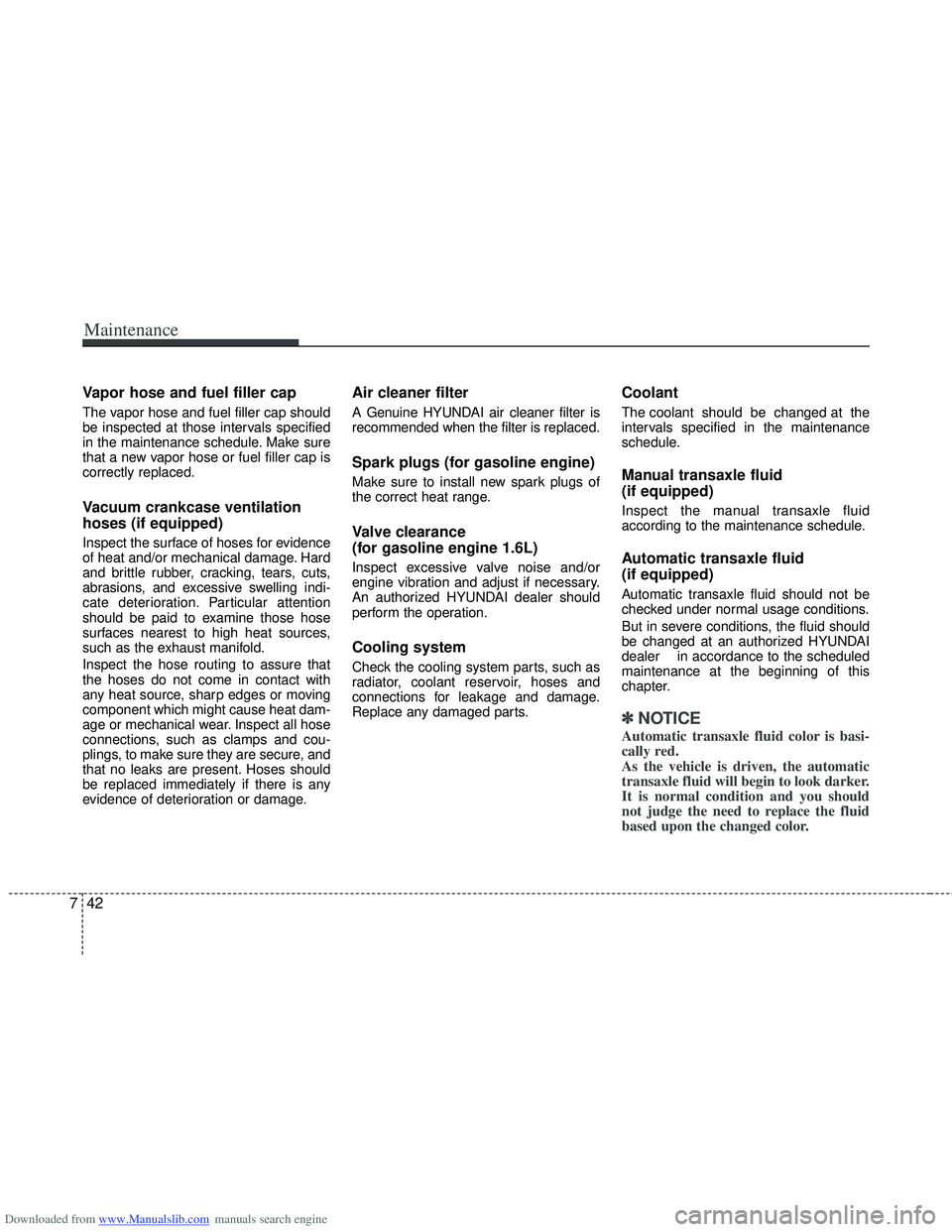
Downloaded from www.Manualslib.com manuals search engine Maintenance
42
7
Vapor hose and fuel filler cap
The vapor hose and fuel filler cap should
be inspected at those intervals specified
in the maintenance schedule. Make sure
that a new vapor hose or fuel filler cap is
correctly replaced.
Vacuum crankcase ventilation
hoses (if equipped)
Inspect the surface of hoses for evidence
of heat and/or mechanical damage. Hard
and brittle rubber, cracking, tears, cuts,
abrasions, and excessive swelling indi-
cate deterioration. Particular attention
should be paid to examine those hose
surfaces nearest to high heat sources,
such as the exhaust manifold.
Inspect the hose routing to assure that
the hoses do not come in contact with
any heat source, sharp edges or moving
component which might cause heat dam-
age or mechanical wear. Inspect all hose
connections, such as clamps and cou-
plings, to make sure they are secure, and
that no leaks are present. Hoses should
be replaced immediately if there is any
evidence of deterioration or damage.
Air cleaner filter
A Genuine HYUNDAI air cleaner filter is
recommended when the filter is replaced.
Spark plugs (for gasoline engine)
Make sure to install new spark plugs of
the correct heat range.
Valve clearance
(for gasoline engine 1.6L)
Inspect excessive valve noise and/or
engine vibration and adjust if necessary.
An authorized HYUNDAI dealer should
perform the operation.
Cooling system
Check the cooling system parts, such as
radiator, coolant reservoir, hoses and
connections for leakage and damage.
Replace any damaged parts.
Coolant
The coolant should be changed at the
intervals specified in the maintenance
schedule.
Manual transaxle fluid
(if equipped)
Inspect the manual transaxle fluid
according to the maintenance schedule.
Automatic transaxle fluid
(if equipped)
Automatic transaxle fluid should not be
checked under normal usage conditions.
But in severe conditions, the fluid should
be changed at an authorized HYUNDAI
dealer in accordance to the scheduled
maintenance at the beginning of this
chapter.
✽ ✽
NOTICE
Automatic transaxle fluid color is basi-
cally red.
As the vehicle is driven, the automatic
transaxle fluid will begin to look darker.
It is normal condition and you should
not judge the need to replace the fluid
based upon the changed color.